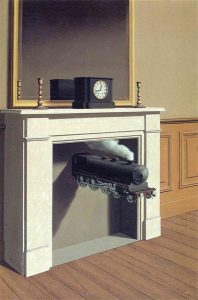René Magritte
.jpg!Large.jpg)
The Belgian artist René Magritte (1898-1967) painted Surrealist images of a more veristic kind. Individually they are realistic, often to the point of creating an illusion. However, their context, size, or their juxtaposition of objects in unrealistic or possible only in a world of dreams.
Magritte’s False Mirror of 1928 depicts a large eye (from which the familiar CBS logo was derived). The black circle at the center can refer both to the pupil and to an eclipsed sun. The observer is thrown off balance by the unusual close-up view of the “eye” as well as by its unexpected character. We do not know if we are looking into the eye and seeing a reflection of the sky, or if we are inside the eye, looking past the pupil at the sky. The “mirror” is “false” because it plays a visual trick.

In Time Transfixed (La Durée poignardée in French) of 1938, Magritte juxtaposed two familiar objects in order to create an unfamiliar effect. Various motifs in this work are clearly depicted and easily identifiable, but their relation to each other is odd, and they convey an impression of immobility and timelessness. The clock indicates a specific hour, but the candlesticks are empty. The cold, sterile room, composed almost entirely of rectangular forms, is devoid of human figures. A steam engine has burst through the fireplace but without disrupting the wall. The shadow cast by the train is unexplained because there is no light source to account for it. The smoke, which indicates that the train is moving although it looks stationary, disappears up the chimney.[1]
- Laurie Schneider Adams, Art Across Time, vol. 2, 4th ed., (New York: McGraw-Hill, 2011), 874. ↵

